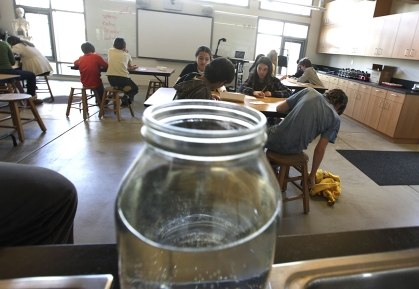Water scarcity is a result of an imbalance between the supply of and demand for water sources in a geographical area. A limited or inadequate water supply is one of the toughest issues facing the world's poorest countries, but the populations of these countries are not the only populations to endure the burden of water scarcity.1,2 As Levy and Sidel correctly point out, distribution in water-strained settings is the source of numerous conflicts globally.3 Most dialogues about this topic, either explicitly or implicitly, talk about water stress and conflict as an issue limited to the low- and middle-income tropical or subtropical countries, as most of their examples affirm.3 As a result, limited literature and discussion exists on the public health effects of water scarcity in wealthier countries or regions such as the United States,4,5 Europe,6 Australia,7,8 or the Asia-Pacific where water scarcity threatens regional food security through a number of ecological, political, and economic pathways.9 Perhaps this paucity of discourse stems from a false notion that these countries and regions do not currently and will not contend with the further consequences of population growth, urbanization, and anthropogenic and natural climate change. However, such an assumption would be far from the truth10 as emerging empirical literature from these regions confirms.5–9
A jar of water sits on a counter in the new science building at the Bertschi School in Seattle, WA, which is one of several dozen nationwide that recycle and manage rainwater and wastewater on site. Photograph by Ted S. Warren. Printed with permission of AP Wide World.
Insufficient access to water and ensuing water stress is undoubtedly a major global public health threat and challenge for our generation. As Levy and Sidel discuss, many roles exist for public health professionals in shaping and “ensuring equitable access to freshwater.”3(p779) Where public health workers devote their efforts and pick their battles is often determined by the literature and surrounding debate. In this instance, I pose that a broader debate and research agenda is needed. The majority of collective public health efforts ought to be directed to those countries striving to attain Millennium Development Goal (MDG) Target 7C: “Halve, by 2015, the proportion of the population without sustainable access to safe drinking water and basic sanitation” (available at: http://www.un.org/millenniumgoals). However, our dialogue and concern should not be limited to only those countries striving to attain MDG 7.C. By doing so we, as public health workers, risk not only overlooking a number of populations with imminent water issues in our own backyards4,5,7,8 but also missing some easy successes in populations with enormous per capita water consumption compared with those populations struggling with MDG Target 7C.
References
- 1.McDonald RI, Green P, Balk D, et al. Urban growth, climate change, and freshwater availability. Proc Natl Acad Sci U S A. 2011;108(15):6312–6317 [DOI] [PMC free article] [PubMed] [Google Scholar]
- 2.Dar OA, Khan MS. Millennium development goals and the water target: details, definitions and debate. Trop Med Int Health. 2011;16(5):540–544 [DOI] [PubMed] [Google Scholar]
- 3.Levy BS, Sidel VW. Water rights and water fights: preventing and resolving conflicts before they boil over. Am J Public Health. 2011;101(5):778–780 [DOI] [PMC free article] [PubMed] [Google Scholar]
- 4.Fuller AC, Harhay MO. Population Growth, Climate Change and Water Scarcity in the Southwestern United States. Am J Environ Sci. 2010;6(3):249–252 [DOI] [PMC free article] [PubMed] [Google Scholar]
- 5.MacDonald GM. Climate Change and water in Southwestern North America special feature: water, climate change, and sustainability in the southwest. Proc Natl Acad Sci U S A. 2010;107(50):21256–21262 [DOI] [PMC free article] [PubMed] [Google Scholar]
- 6.Falloon P, Betts R. Climate impacts on European agriculture and water management in the context of adaptation and mitigation–the importance of an integrated approach. Sci Total Environ. 2010;408(23):5667–5687 [DOI] [PubMed] [Google Scholar]
- 7.Keath NA, Brown RR. Extreme events: being prepared for the pitfalls with progressing sustainable urban water management. Water Sci Technol. 2009;59(7):1271–1280 [DOI] [PubMed] [Google Scholar]
- 8.Brown RR, Keath N, Wong TH. Urban water management in cities: historical, current and future regimes. Water Sci Technol. 2009;59(5):847–855 [DOI] [PubMed] [Google Scholar]
- 9.Butler CD. Food security in the Asia-Pacific: climate change, phosphorus, ozone and other environmental challenges. Asia Pac J Clin Nutr. 2009;18(4):590–597 [PubMed] [Google Scholar]
- 10.Fung F, Lopez A, New M. Water availability in +2{degrees}C and +4{degrees}C worlds. Philos Transact A Math Phys Eng Sci. 2011;369(1934):99–116 [DOI] [PubMed] [Google Scholar]



